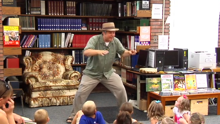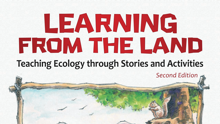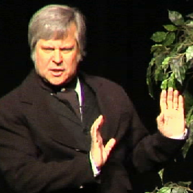Groundhog’s Tale
A Traditional Cherokee Tale Retold By Brian “Fox” Ellis
A Traditional Cherokee Tale Retold By Brian “Fox” Ellis
(c) Fox Tales International 2007
This story also appears on my CD Fun With Fables.
Have you ever seen a groundhog? Then you know that a groundhog is plump and round. He has short stubby arms and legs and a short stubby tail. But it has not always been so. Some folks believe that he used to have a big bushy tail, bushier than a fox’s tail. What? You doubt me? Well, any scientist will tell you that a groundhog is in the rodent family, like squirrels and beavers, and they both have longer tails. It’s possible. I would like to tell you the story of how Groundhog lost his tail:
If you know Groundhog, then you know that he likes to sleep all winter long. Would you like to sleep for three months? Think about it. If you slept for three months that would mean that you would have nothing to eat for three months. The truth is that your body can’t handle that, you would starve. But a groundhog’s body is different. They put on a thick layer of fat in the fall and burn that fat all winter long.
In the spring when Groundhog wakes up he has one thing on his mind, looking for something good to eat! He comes up out of his hole and begins sniffing around. He digs up sweet juicy roots. He loves green tender shoots. He nibbles the bark and leaves off of some bushes and trees. Yea, that’s right, Groundhog is a vegetarian.
But he was not the only one who was hungry. As he wandered here and there, further and further from the safety of his hole, he wasn’t the only one who was hungry. Because he was paying so much attention to his food he stopped paying attention to what was happening around him in the forest and he wasn’t the only one who was hungry.
As he was digging up this big juicy root, A-R-RG, he was suddenly surrounded by seven big hungry wolves who said, “HA, HA, HA, HA, Now we caught you. Now we are going to eat you!”
Wolves once ranged most of North America.

“Uh-oh!” Groundhog was in trouble. But don’t worry about Groundhog. Groundhog thought fast. He was smart. He knew that his mind could solve problems better than his fists, especially since he had such tiny little fists. He knew that his fists had gotten him into trouble in the past. Have you ever had your fists get you into trouble? Yeah, you can admit it.
Use your brain next time; that is what Groundhog did. He said, “Uh, uh, uh, you got me. You should go ahead and eat me. But, but, but before you eat me you should say a little prayer for me.” Do you say a prayer before you eat? Some people do, some people don’t, religious tolerance is what America’s all about. But Groundhog knew something that maybe you do not know; the Cherokee sing songs and perform dances to honor the corn before they harvest. It’s called the Green Corn Ceremony.
Groundhog thought that was a good idea. He said, “Why don't you wolves sing a song and do a dance to honor me, then you can eat me.”
Everyone knows that wolves love to sing. Can you sing like a wolf? Hoooooowwwlll. But one thing a lot of people don't know is that wolves also love to dance. One of the wolves said, “Yes, we love to sing and dance before a meal. That way we can really work up an appetite and you will taste even better. Ha, ha, ha, ha.” So Groundhog said, "Well, uh, here, ...it'll go kind of like this," and he just made it up as he went along. He said, "I'll sing this part, "Hawaa, yeehi, you" and when I say you, I want all of you to (imagine that you are wolves and) sing: "Hi ya goey". Let's practice. Ready? I’ll sing my part and you sing yours: "Hawaa, yeehi, you". "Hi ya goey".
“Got it? Good,” said Groundhog, “Now here's the dance.” Groundhog was just making it up as he went along. “When I sing my part, I want you to do this kind of dance, do a little dance away from me. Yeah, that’s right, far away from me. And when you sing your part you can turn around and race back. The first one back, you get to eat me. There are seven wolves so we will do it seven times and the first one back on the seventh time you can eat me.”
Well, the wolves loved that idea. Each wolf thought to him or her self: “I might be the first one back and get him all to myself and not have to share with anybody else. Ha, Ha, Ha, Ha.” That is what the wolves thought.
Little did they know that Groundhog had a few tricks up his sleeve, even though he wasn’t wearing any. Groundhog started to sing and the wolves started to dance. "Hawaa, yeehi, you". "Hi ya goey". "Hawaa, yeehi, you". "Hi ya goey". (Step backwards each time you sing.)
Maybe you noticed but the wolves did not, each time Groundhog sang his part, while the wolves weren't looking, Groundhog moved a little closer to his hole. "Hawaaaa, yeehiii, you". "Hi ya goey". "Hawaaaa, yeehiii, you". "Hi ya goey". (Step back and sing a little longer each time.) Maybe you noticed but the wolves did not, each time he sang his part, Groundhog sang a little bit longer so the wolves danced further and further away, while Groundhog moved closer and closer to his hole. "Hawaaaaaa, yeehiiii, you". "Hi ya goey". "Hawaaaaa, yeehiiiii, you". "Hi ya goey".
Have you been counting? By the seventh time, Groundhog was singing a real long time and the wolves were dancing far, far away. By the seventh time he was standing right next to his hole. "Hawaaaaaaaa, yeehiiiiiii, you". "Hi ya goey". (Sing as long as you can hold a note!)
Groundhog just stepped right into his hole. ARG! Just before he disappeared one of the wolves grabbed onto his tail. Ow! Groundhog pulled. Arg, the wolf pulled harder. OOW! Groundhog pulled harder. ARG! The wolf pulled even harder. Groundhog pulled as hard as he could and the wolf pulled as hard as he could. POP! His tail broke right off. Well, I can see some of you are worried, but don’t worry about Groundhog. Groundhog really didn't mind, no, he didn’t mind losing a little bit of his tail as long as he kept his life. Which would you rather have? "Hawaa, yeehi, you". "Hi ya goey".
TIPS FOR TELLING: As you can see in this transcription, this story has lots of opportunity for audience participation. You can invite them to howl. You can invite the audience to sing the wolves part of the song each time, after you sing the groundhog’s song. There are several places where you can carry on a rhetorical dialogue allowing the audience to raise their hand in response to questions instead of answering aloud. For example, you can ask them to raise their hand if they have ever had their fists get them into trouble, or if they have seen a groundhog, or if they say a prayer before they eat. Two of my favorite parts are the jump scenes at the beginning and end. When the groundhog is gathering food and wandering away from the safety of his hole you can build suspense with the repetitive line, “but he wasn’t the only one who was hungry.” Lulling them with a quieter voice you can startle them with a loud growl when the wolves first appear. In a similar fashion you can startle them again when the wolf catches the tail near the end. I like to give the wolves a dastardly, gruff voice and the groundhog a shrill, high voice. Singing the song one last time at the end brings closer.
ABOUT THE STORY: I first found this story in George Scherer's Cherokee Animal Stories. Later, I went to his source, James Mooney's Myths and History of the Cherokee. Mooney’s source for many of his stories was John Ross, Principal Chief of the Cherokee in the mid 1800’s and great-great grandfather of Gayle Ross, a wonderful storyteller who published a different version in her book How Rabbit Tricked Otter. This story also appears on my CD Fun With Fables. A Cherokee elder I met when I lived in the North Carolina Mountains once told me the real reason groundhog comes out of his hole in February. It is not so he can see his shadow and predict the weather. It is the mating season for groundhogs. The male groundhogs come out of their hole to paw around and sniff the other holes to see if a female lives there. Mountain people knew that. At that time of year their winter food supply might be running low, spring was just a little way off. So they would go out to the groundhog holes and they would drum. The groundhog is known as the drummer because when he smells a female hole he drums on the hole to call out the female. So people would take two sticks and go visit the groundhog holes. They would drum on the holes. And when the groundhog came out they would catch it and eat it. Often they would use the skin to make drums. Groundhog skin makes a great drum (and banjo heads), because it's really thin and really strong. In part, this is a story about the groundhog and why he loved to play his drums.









